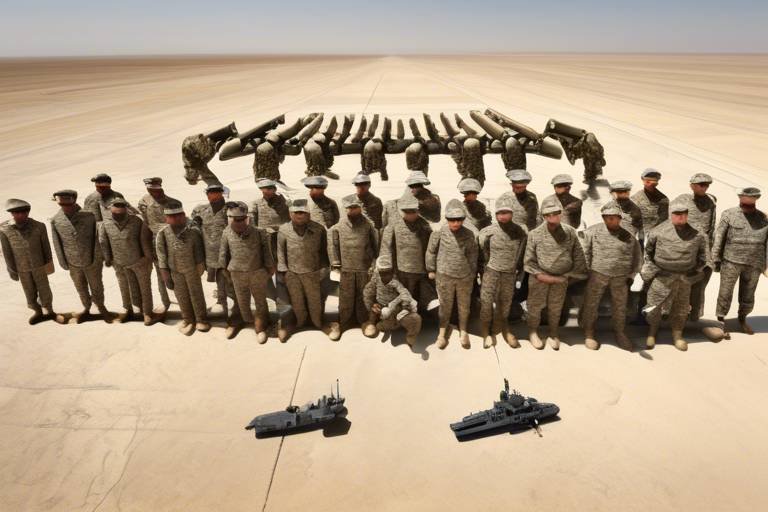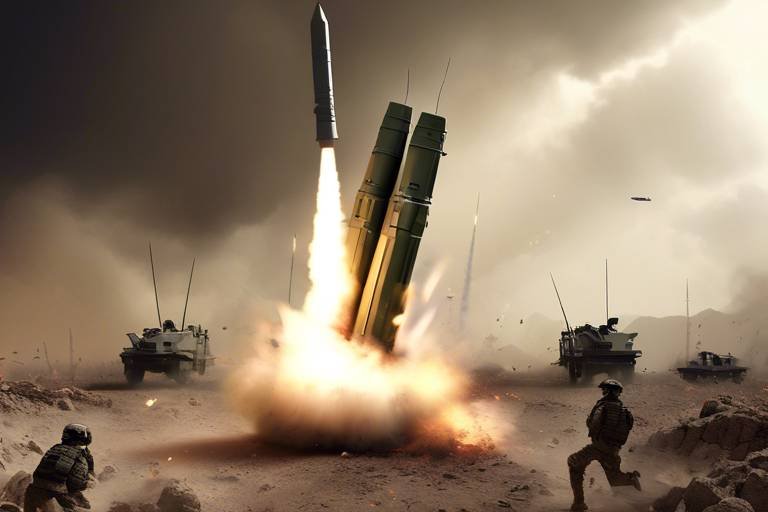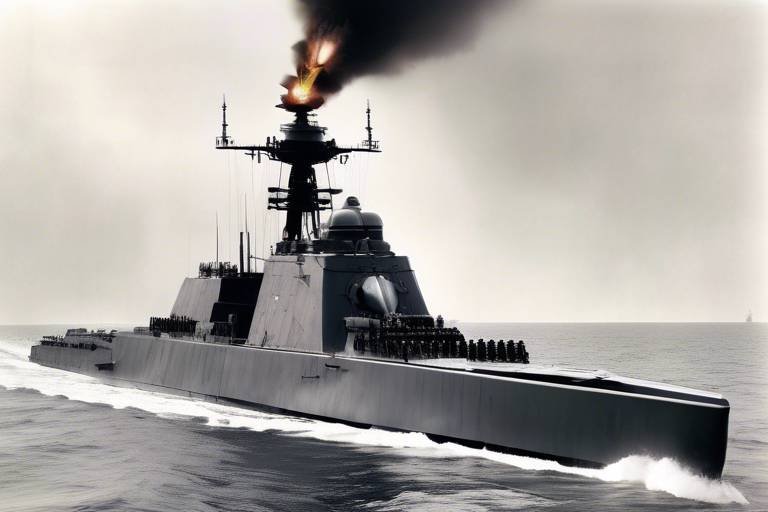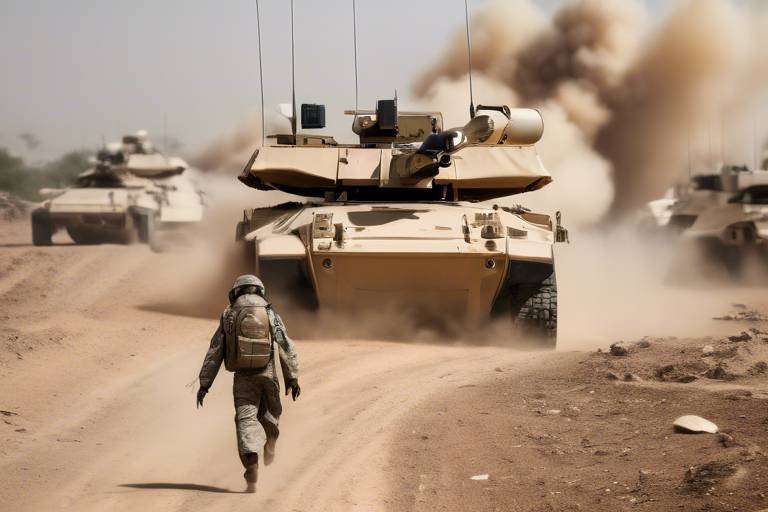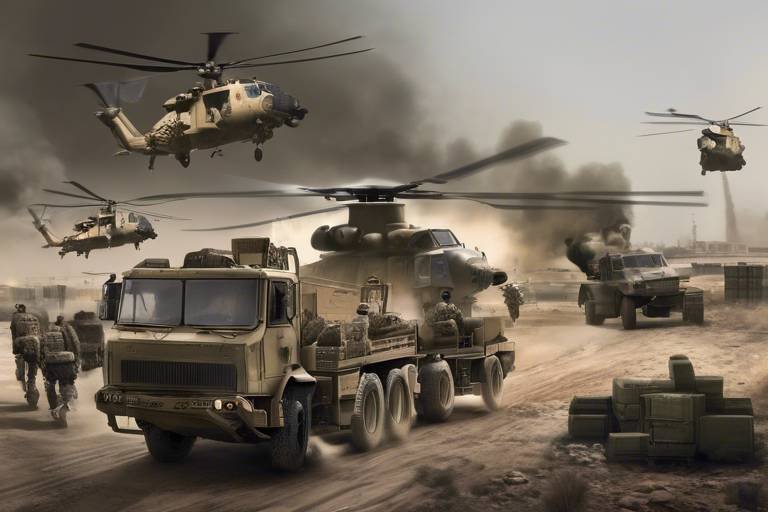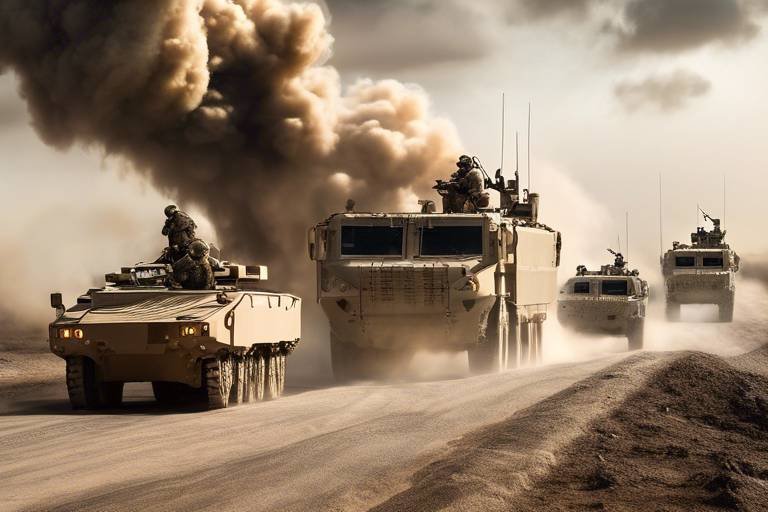The Evolution of Global Defense Cooperation Initiatives
The world we live in today is intricately woven with a tapestry of defense cooperation initiatives that have evolved significantly over the decades. From the ashes of World War II, nations recognized the urgent need for collaboration to ensure peace and stability. This article takes you on a journey through the historical development, current trends, and future prospects of these initiatives, shedding light on their critical role in addressing contemporary security challenges and fostering international partnerships.
Initially, the seeds of defense cooperation were sown in the aftermath of global conflict. Countries were not only looking to protect their borders but also to create a framework for collective security. The formation of NATO in 1949 marked a pivotal moment, as it established a formal alliance among Western nations against the backdrop of the Cold War. This was more than just a military pact; it was a commitment to safeguard democratic values and promote stability in a world rife with uncertainty.
Fast forward to today, and we see a landscape where defense cooperation has expanded beyond traditional alliances. Various nations are now collaborating through regional organizations and coalitions, adapting to the complexities of modern threats such as terrorism, cyber warfare, and climate change. The rise of non-state actors and transnational issues has necessitated a more dynamic approach to security, prompting nations to look beyond their borders and engage in innovative partnerships.
One of the most significant trends in recent years is the increasing importance of technology in defense cooperation. The integration of advanced technologies, such as cyber capabilities and artificial intelligence, has transformed how nations communicate and coordinate during crises. This shift not only enhances operational efficiency but also enables quicker responses to emerging threats. As nations invest in cutting-edge technologies, the landscape of defense cooperation continues to evolve, reflecting the changing nature of warfare and security.
Moreover, globalization plays a crucial role in shaping defense initiatives. As countries become more interdependent, the need for comprehensive defense strategies that consider economic, political, and social dimensions has become evident. Nations are recognizing that security cannot be achieved in isolation; it requires a collaborative effort that encompasses various sectors and stakeholders. This interconnectedness has led to more robust partnerships and a shared understanding of global security challenges.
In summary, the evolution of global defense cooperation initiatives is a testament to humanity's resilience and adaptability in the face of adversity. As we navigate the complexities of the modern world, these initiatives will continue to play a vital role in fostering peace and security. By understanding their historical context, recognizing the key players involved, and acknowledging the impact of globalization and technology, we can appreciate the significance of defense cooperation in addressing the challenges of today and tomorrow.

Historical Context of Defense Cooperation
The concept of defense cooperation is not a new phenomenon; it has evolved significantly over the decades, particularly in the aftermath of major global conflicts. The end of World War II marked a pivotal moment in international relations, as nations recognized the necessity of forming alliances to ensure collective security. The devastation wrought by the war underscored the fragility of peace and prompted countries to seek collaborative frameworks to deter future conflicts. This era birthed organizations like the North Atlantic Treaty Organization (NATO) in 1949, which was established to counter the perceived threat of Soviet expansion and to provide a unified defense strategy for its member states.
As geopolitical tensions escalated during the Cold War, defense cooperation initiatives took on new dimensions. Countries began to understand that isolated defense strategies were insufficient in addressing the complexities of global security threats. The establishment of the United Nations (UN) in 1945 also played a crucial role in promoting international cooperation, as it aimed to foster dialogue and prevent conflicts through collective action. The UN Security Council became a platform for nations to address security concerns collaboratively, albeit with varying degrees of success.
In addition to NATO and the UN, various regional organizations emerged, reflecting the need for localized defense strategies tailored to specific threats. For instance, the Organization of American States (OAS) was created to address security issues in the Americas, while the African Union (AU) aimed to enhance stability across the African continent. These organizations not only facilitated military cooperation but also encouraged political dialogue and economic partnerships among member states.
As we look at the historical context of defense cooperation, it is essential to consider the impact of technological advancements. The Cold War era saw significant military innovations, including nuclear weapons, which fundamentally altered the landscape of defense strategies. The arms race between the United States and the Soviet Union exemplified how technological superiority became a critical factor in defense cooperation, leading to treaties like the Strategic Arms Limitation Talks (SALT) aimed at curbing the arms race.
Furthermore, the post-Cold War period ushered in a new era of security challenges, including terrorism, cyber threats, and regional conflicts. These evolving threats necessitated a reevaluation of defense cooperation frameworks. Countries began to recognize that traditional military alliances needed to adapt to address non-state actors and asymmetric warfare. This shift has led to increased collaboration not only among military entities but also with intelligence agencies, law enforcement, and non-governmental organizations.
In summary, the historical context of defense cooperation highlights a journey marked by the need for collective security, the influence of geopolitical dynamics, and the adaptation to emerging threats. As nations continue to navigate a complex security landscape, the lessons learned from past alliances and the evolution of cooperative strategies will undoubtedly shape the future of global defense initiatives.
- What is the primary purpose of defense cooperation initiatives?
The primary purpose is to enhance collective security among nations by fostering collaboration, sharing resources, and addressing common threats.
- How did World War II influence defense cooperation?
World War II underscored the need for alliances to prevent future conflicts, leading to the formation of organizations like NATO and the UN.
- What role do technological advancements play in defense cooperation?
Technological advancements have transformed defense strategies, enabling better communication, coordination, and response capabilities among allied nations.
- Why are regional organizations important for defense cooperation?
Regional organizations address specific security concerns and enhance stability through collective action tailored to local contexts.

Key Players in Defense Alliances
When we talk about defense alliances, it’s essential to highlight the key players that shape these critical partnerships. Nations and organizations come together, often driven by a shared sense of security and the need to address common threats. One of the most significant players in this arena is the North Atlantic Treaty Organization (NATO). Established in 1949, NATO has been a cornerstone of transatlantic defense cooperation, bringing together 30 member countries committed to mutual defense. The collective defense clause, enshrined in Article 5, underscores the alliance's principle that an attack on one is an attack on all, making it a formidable deterrent against aggression.
Another pivotal organization is the United Nations (UN), which plays a crucial role in fostering international peace and security. Through its peacekeeping missions and various security councils, the UN facilitates dialogue and cooperation among nations, addressing conflicts before they escalate into larger threats. The UN's ability to bring countries together for collective action is vital, especially in an era where global challenges are increasingly complex and interconnected.
In addition to these global players, regional coalitions also significantly influence defense strategies. For instance, organizations like the European Union (EU) and the African Union (AU) have established frameworks for collaboration that address specific regional security concerns. The EU has developed its own defense initiatives, including the Permanent Structured Cooperation (PESCO), which aims to deepen defense cooperation among member states. Similarly, the AU has been active in peacekeeping missions across Africa, showcasing how regional organizations can effectively respond to localized threats.
Furthermore, countries like the United States, Russia, and China play dominant roles in shaping global defense dynamics. The U.S. has a vast network of alliances, including bilateral agreements with countries like Japan and South Korea, which are crucial in maintaining stability in the Asia-Pacific region. On the other hand, Russia's military alliances, particularly within the Collective Security Treaty Organization (CSTO), reflect its strategic interests in post-Soviet states. Meanwhile, China is increasingly asserting its influence through initiatives like the Shanghai Cooperation Organization (SCO), focusing on security cooperation among member states.
Each of these players brings unique perspectives and capabilities to the table, creating a complex web of interactions that define modern defense cooperation. The interplay of these alliances is not static; it evolves with changing geopolitical landscapes and emerging threats. For instance, the rise of cyber warfare and terrorism has prompted many of these organizations to adapt their strategies and enhance their collaborative efforts.
| Organization | Year Established | Key Focus Areas |
|---|---|---|
| NATO | 1949 | Collective defense, crisis management |
| UN | 1945 | International peace, conflict resolution |
| EU (PESCO) | 2017 | Defense cooperation, military readiness |
| African Union | 2001 | Peacekeeping, regional stability |
| Collective Security Treaty Organization (CSTO) | 1992 | Military cooperation, regional security |
In summary, the landscape of defense alliances is shaped by various key players, each contributing to a broader strategy of collective security. As we navigate through the complexities of modern threats, the importance of these alliances cannot be overstated. They are not just about military might; they embody the spirit of cooperation and shared responsibility among nations, paving the way for a more secure global environment.
- What is NATO? - NATO is a military alliance established in 1949 for collective defense among its member states.
- How does the UN contribute to global security? - The UN facilitates international cooperation through peacekeeping missions and conflict resolution efforts.
- What role do regional organizations play in defense? - Regional organizations address specific security concerns and enhance stability through collaboration among member states.
- Why are economic factors important in defense cooperation? - Economic considerations, such as defense spending and arms trade, influence the dynamics of alliances and partnerships.

Regional Defense Organizations
Regional defense organizations serve as crucial platforms for nations to collaborate on security issues that are often too complex or localized for unilateral action. These organizations, like the African Union (AU) and the Association of Southeast Asian Nations (ASEAN), play a vital role in fostering cooperation among member states, addressing specific security concerns that impact the region as a whole. The significance of these organizations cannot be overstated; they not only promote peace and stability but also enhance the collective capability to respond to various threats, ranging from terrorism to natural disasters.
Take, for example, the African Union, which has been instrumental in mediating conflicts and deploying peacekeeping missions across the continent. The AU’s Peace and Security Council is a testament to this commitment, enabling swift action in times of crisis. Similarly, ASEAN has developed the ASEAN Regional Forum (ARF), which facilitates dialogue on security issues among its member states and external partners. This proactive approach helps to mitigate tensions and build trust, which is essential in a region marked by diverse political landscapes.
However, the effectiveness of these regional organizations often hinges on the ability to navigate the unique challenges they face. Political differences among member states can create significant hurdles. For instance, while one country may prioritize counter-terrorism efforts, another might focus on economic development, leading to a mismatch in objectives. Additionally, resource limitations can hamper the capability of these organizations to conduct joint operations effectively. The disparity in military capabilities among member states can create imbalances that complicate collaborative efforts.
Despite these challenges, there have been notable success stories that highlight the potential for effective regional cooperation. For instance, the AU's intervention in the crisis in Mali in 2013 showcased how regional actors could come together to address a significant security threat. Similarly, ASEAN's commitment to disaster response has led to the establishment of the ASEAN Coordinating Centre for Humanitarian Assistance on Disaster Management (AHA Centre), which has proven invaluable in coordinating relief efforts during natural disasters.
In summary, regional defense organizations are indispensable in the global security landscape. They not only address immediate security concerns but also foster long-term partnerships among nations. As the world becomes increasingly interconnected, the role of these organizations will only grow in importance, underscoring the need for continued investment in their capacities and collaborative frameworks.
- What are regional defense organizations?
Regional defense organizations are collaborative entities formed by countries within a specific geographic area to address security challenges and enhance regional stability. - How do regional organizations differ from global alliances?
Regional organizations typically focus on specific regional issues and foster cooperation among neighboring countries, while global alliances address broader security concerns across multiple regions. - Can regional organizations effectively manage security threats?
Yes, regional organizations can effectively manage security threats by leveraging local knowledge, resources, and political will, although challenges such as political differences and resource limitations may arise.

Challenges Faced by Regional Organizations
Regional organizations play a crucial role in fostering defense cooperation among member states. However, they often encounter a myriad of challenges that can impede their effectiveness. One of the most significant obstacles is the presence of political differences among member nations. Each country has its own political agendas, which can lead to conflicts of interest and hinder consensus on key security issues. For instance, a nation may prioritize its national interests over collective security, causing friction within the organization.
Another challenge is resource limitations. Many regional organizations operate with constrained budgets and limited military capabilities. This lack of resources can severely restrict their ability to conduct joint exercises, share intelligence, or respond to crises effectively. For example, the African Union has faced criticism for its inability to deploy peacekeeping forces promptly due to funding shortages, highlighting how financial constraints can stymie crucial defense initiatives.
Moreover, the varying national interests of member states can complicate collaborative efforts. Countries may have different perspectives on security threats, which can lead to disagreements on the best course of action. This divergence can manifest in situations where some nations prioritize counter-terrorism efforts, while others focus on border security, thereby diluting the overall effectiveness of the organization’s strategies.
Furthermore, the lack of trust among member states can pose a significant barrier to effective cooperation. Historical grievances, territorial disputes, or past conflicts can create an atmosphere of suspicion, making it difficult for nations to work together. Building trust is essential for successful collaboration, yet it often takes years of diplomatic efforts and mutual understanding to achieve.
Lastly, the rapidly changing global security landscape presents another challenge for regional organizations. With the rise of non-state actors, cyber threats, and transnational terrorism, the traditional defense strategies may not suffice. Regional organizations must adapt quickly to these evolving threats, requiring agility and innovation in their approaches. However, adapting to new security paradigms often necessitates comprehensive training, updated technologies, and a reevaluation of existing protocols, which can be daunting tasks for many organizations.
In summary, while regional organizations are pivotal in enhancing defense cooperation, they face significant challenges that can impede their effectiveness. Addressing these issues requires a concerted effort from all member states, focusing on building trust, aligning national interests, and securing adequate resources to respond to contemporary security challenges.
- What are the main challenges faced by regional defense organizations?
The main challenges include political differences among member states, resource limitations, varying national interests, lack of trust, and the rapidly changing global security landscape.
- How do political differences affect defense cooperation?
Political differences can lead to conflicts of interest, making it difficult for member states to reach a consensus on security issues and strategies.
- Why is resource limitation a significant issue?
Resource limitations restrict the ability of regional organizations to conduct joint exercises, share intelligence, and respond to crises effectively.
- How can trust be built among member nations?
Building trust requires years of diplomatic efforts, mutual understanding, and addressing historical grievances that may exist between nations.
- What impact does the changing global security landscape have?
The changing landscape necessitates that regional organizations adapt their strategies to address new threats, which can be a daunting task requiring innovation and updated protocols.

Success Stories in Regional Cooperation
In the complex landscape of global defense, the stories of successful regional cooperation initiatives shine as beacons of hope and collaboration. One prime example is the African Union (AU), which has made significant strides in addressing conflicts and crises across the continent. The AU's deployment of the African Standby Force (ASF) showcases its commitment to swift and effective responses to security threats. This initiative not only enhances regional stability but also fosters a sense of ownership among African nations in managing their security challenges.
Another noteworthy success can be seen in the Association of Southeast Asian Nations (ASEAN), which has cultivated a culture of dialogue and collaboration among its member states. Through initiatives like the ASEAN Regional Forum (ARF), countries have engaged in joint exercises and discussions aimed at enhancing mutual understanding and cooperation. These efforts have led to the establishment of trust, allowing nations to work together more effectively on security issues, particularly in areas such as counter-terrorism and disaster response.
The collaborative efforts of the North Atlantic Treaty Organization (NATO) also exemplify success in regional defense cooperation. NATO's Enhanced Forward Presence (eFP) in Eastern Europe demonstrates a united front against potential threats. By stationing multinational battlegroups in member states, NATO not only strengthens collective defense but also reassures nations of their commitment to shared security. This proactive approach has been pivotal in deterring aggression and maintaining peace in a volatile region.
Moreover, the European Union (EU) has made significant advancements in defense cooperation through initiatives like the Permanent Structured Cooperation (PESCO). This framework enables EU member states to collaborate on defense projects, enhancing military capabilities and readiness. The establishment of the European Defence Fund further supports joint research and development efforts, fostering innovation and efficiency in defense spending. These initiatives highlight the importance of collective action in addressing contemporary security challenges.
Despite the myriad of challenges faced by regional organizations, these success stories illustrate the potential for effective cooperation. By sharing resources, expertise, and intelligence, nations can address common threats more efficiently. The achievements of the AU, ASEAN, NATO, and the EU serve as powerful reminders that when countries come together, they can overcome obstacles and create a safer world for all.
- What is the African Standby Force?
The African Standby Force (ASF) is a regional military force established by the African Union to enable swift responses to conflicts and crises across Africa. - How does ASEAN promote defense cooperation?
ASEAN promotes defense cooperation through platforms like the ASEAN Regional Forum (ARF), which encourages dialogue and joint exercises among member states. - What role does NATO play in regional security?
NATO plays a crucial role in regional security by providing a collective defense framework, exemplified by initiatives like the Enhanced Forward Presence in Eastern Europe. - What is PESCO in the context of the EU?
Permanent Structured Cooperation (PESCO) is an EU initiative that allows member states to collaborate on defense projects, enhancing military capabilities and readiness.

Technological Advancements in Defense Cooperation
The landscape of global defense cooperation has been dramatically transformed by technological advancements. In an era where information is power, nations are increasingly leveraging cutting-edge technologies to enhance their collaborative efforts. From cybersecurity measures to artificial intelligence (AI), these innovations are not just tools; they are the backbone of modern defense strategies. Imagine a world where military operations are coordinated in real-time across continents, with data being shared instantaneously to respond to threats as they arise. This is no longer science fiction; it's the reality of contemporary defense initiatives.
One of the most significant shifts has been the rise of cyber capabilities. As cyber threats become more sophisticated, nations are compelled to work together to safeguard their digital infrastructure. This has led to the establishment of joint cyber defense initiatives, where countries share intelligence and resources to combat common adversaries. For instance, NATO has developed a Cyber Defence Policy that encourages member states to collaborate on cyber threats, illustrating how technology can foster unity in the face of adversity.
Furthermore, the integration of artificial intelligence into defense strategies is revolutionizing how nations approach security. AI can analyze vast amounts of data faster than any human, identifying patterns and potential threats that might go unnoticed otherwise. This capability allows for more informed decision-making and quicker responses in crisis situations. Countries like the United States and China are investing heavily in AI research, understanding that the future of warfare may very well depend on who can harness this technology most effectively.
Additionally, advancements in drone technology have changed the dynamics of military operations. Drones are no longer just tools for surveillance; they are being used in combat situations, logistical support, and even humanitarian missions. The ability to deploy drones for joint operations has led to unprecedented levels of cooperation. For example, during multinational exercises, drones can be used to simulate attacks or reconnaissance missions, allowing forces from different countries to train together and improve their interoperability.
Moreover, the emergence of cloud computing has facilitated seamless communication between allied nations. By utilizing shared platforms, military forces can exchange information quickly and securely, ensuring that all parties are on the same page. This is critical, especially during joint operations where timing and coordination are essential. The ability to access and analyze shared data in real-time enhances situational awareness and allows for more effective strategic planning.
However, it is essential to recognize that with these advancements come significant challenges. The reliance on technology can create vulnerabilities, especially if cyber defenses are not adequately fortified. Nations must balance their technological investments with robust security measures to protect against potential breaches and ensure that their collaborative efforts are not undermined by cyber threats.
In conclusion, as we look to the future, it is clear that technological advancements will continue to play a pivotal role in shaping global defense cooperation. By embracing these innovations, nations can enhance their collective security, respond to threats more effectively, and foster stronger partnerships. The question remains: how will these technologies evolve, and what new challenges will they bring? Only time will tell, but one thing is certain—the future of defense cooperation is inextricably linked to the progress of technology.
- What role does technology play in modern defense cooperation?
Technology enhances communication, data analysis, and operational efficiency among allied nations, making defense cooperation more effective. - How do cyber capabilities influence defense strategies?
Cyber capabilities allow nations to share intelligence and resources to combat common threats, fostering collaboration in cybersecurity efforts. - What impact does artificial intelligence have on military operations?
AI improves decision-making and response times by analyzing vast amounts of data, allowing for quicker identification of potential threats. - Are there risks associated with technological advancements in defense?
Yes, increased reliance on technology can create vulnerabilities, necessitating strong cybersecurity measures to protect against breaches.

Impact of Globalization on Defense Initiatives
The phenomenon of globalization has revolutionized the way nations interact, not just economically but also in terms of security. As countries become more interconnected, the nature of defense cooperation has evolved significantly. This interdependence means that a security threat in one region can quickly become a concern for others, prompting nations to forge stronger alliances and collaborative frameworks. Imagine a web where each strand represents a nation; if one strand is pulled, it affects the entire structure. This analogy highlights the importance of collective security in our increasingly globalized world.
One of the most significant impacts of globalization on defense initiatives is the shift towards comprehensive strategies that encompass various dimensions—economic, political, and social. For instance, countries are no longer merely focused on military capabilities; they are also considering how economic stability, trade relationships, and political alliances can enhance their security posture. The rise of multinational organizations like NATO and the European Union exemplifies this trend, as they work not just on military cooperation but also on economic interdependence and political collaboration.
Moreover, globalization has facilitated the sharing of intelligence and technology, allowing nations to respond more effectively to security threats. With advancements in communication technologies, countries can now collaborate in real-time, sharing critical information that could prevent crises before they escalate. This has led to the development of joint military exercises and training programs that enhance interoperability among allied forces. For example, the integration of cyber capabilities has become a focal point of defense cooperation, as nations recognize that cyber threats know no borders.
However, the impact of globalization on defense initiatives is not without its challenges. As nations become more reliant on one another for security, they also face the risk of political manipulation and the potential for conflicts of interest. For instance, a country might prioritize its economic ties with a partner over collective security commitments, leading to tensions within alliances. Additionally, the varying levels of military capability and readiness among nations can complicate cooperative efforts, as some may struggle to meet the expectations of their allies.
In conclusion, the impact of globalization on defense initiatives is profound and multifaceted. It has transformed the landscape of international security, pushing nations to adopt a more integrated approach to defense. While challenges remain, the potential for enhanced cooperation and collective security is greater than ever. As we look to the future, understanding this dynamic will be crucial in addressing the complex security challenges that lie ahead.
- How has globalization changed defense strategies? Globalization has led to more comprehensive defense strategies that include economic and political dimensions, fostering stronger alliances among nations.
- What role does technology play in defense cooperation? Technology facilitates real-time communication and intelligence sharing, enhancing the effectiveness of joint security efforts among allied nations.
- Are there risks associated with increased interdependence in defense? Yes, increased interdependence can lead to political manipulation and conflicts of interest, complicating cooperative efforts among nations.

Economic Factors Influencing Defense Cooperation
The landscape of global defense cooperation is profoundly shaped by economic factors. These factors not only influence how nations allocate resources for their military but also determine the nature of their alliances. When we think about defense, it's easy to focus solely on military might; however, the underlying economic conditions play a critical role in shaping defense strategies and partnerships. For instance, countries with robust economies tend to have more substantial defense budgets, allowing them to invest in advanced technologies and participate in international defense initiatives. This creates a ripple effect, encouraging other nations to align themselves with economically strong allies to bolster their own security.
Furthermore, the dynamics of arms trade significantly affect defense cooperation. Nations often engage in arms deals not just for military enhancement but also as a means of forging alliances. These transactions can lead to a web of interdependence, where countries rely on each other for military supplies and technologies. For example, consider how the United States' arms sales to various countries serve as a tool for establishing strategic partnerships and enhancing regional security frameworks. This interdependence can sometimes lead to complex diplomatic relations, where economic ties can either strengthen alliances or create friction if interests diverge.
Another essential aspect to consider is how defense spending is influenced by economic conditions. In times of economic prosperity, countries may increase their defense budgets, allowing for more extensive military cooperation and joint exercises. Conversely, during economic downturns, nations might face pressure to cut back on military expenditures, which can lead to reduced participation in international defense initiatives. This fluctuation can create instability in defense cooperation, as nations grapple with balancing domestic economic needs with international security commitments.
Moreover, economic cooperation often goes hand in hand with defense cooperation. Countries that engage in trade partnerships are more likely to collaborate on security issues. The rationale is simple: when nations have strong economic ties, they tend to have a vested interest in maintaining stability and security in each other's regions. This is evident in various trade agreements that include defense clauses, ensuring that economic partners also work together on security matters.
To further illustrate these points, consider the following table that highlights key economic indicators and their impact on defense cooperation among select countries:
| Country | Defense Budget (in billion USD) | GDP (in trillion USD) | Arms Trade Ranking |
|---|---|---|---|
| United States | 740 | 21.43 | 1 |
| China | 250 | 14.34 | 2 |
| Russia | 65 | 1.78 | 3 |
| India | 71 | 2.87 | 4 |
This table highlights how economic strength correlates with defense budgets and arms trade rankings. The more significant a nation’s economic capacity, the more likely it is to engage in robust defense cooperation initiatives. As we move forward, understanding these economic factors will be crucial for predicting how defense alliances will evolve in response to global security challenges.
- What is the role of economics in defense cooperation? Economics plays a crucial role in determining how much countries can invest in their military and defense partnerships.
- How does arms trade influence international relations? Arms trade can create interdependence among nations, fostering alliances based on mutual security interests.
- Can economic downturns affect defense initiatives? Yes, economic downturns can lead to reduced defense spending, impacting a nation's ability to participate in international defense cooperation.

Social and Cultural Dimensions
The social and cultural dimensions of defense cooperation are often underestimated, yet they play a crucial role in shaping the effectiveness of international partnerships. When nations come together to address security challenges, it's not just about military might or strategic interests; it's also about understanding and respecting each other's cultures, values, and social dynamics. This understanding fosters trust and builds stronger alliances, which are essential in today's complex geopolitical landscape.
Consider this: when countries engage in cultural exchanges—be it through joint military exercises, educational programs, or humanitarian missions—they create opportunities for soldiers and officials to interact on a personal level. These experiences help break down barriers and misconceptions that often exist between different nations. For instance, a soldier from the United States working alongside a counterpart from Japan may discover shared values such as dedication, honor, and respect for duty. Such connections can lead to more effective communication and collaboration in times of crisis.
Moreover, the impact of social ties extends beyond the military sphere. Community engagements, such as joint disaster relief efforts or cultural festivals, can significantly enhance a nation’s perception of its allies. These initiatives not only strengthen military ties but also promote a sense of camaraderie among the civilian populations. The more people understand each other’s backgrounds and struggles, the more likely they are to support collaborative defense initiatives. In this way, social and cultural dimensions are intertwined with defense strategies, making them more holistic and sustainable.
However, it’s important to acknowledge that cultural differences can also pose challenges. Misunderstandings arising from varying cultural norms can lead to friction and hinder cooperation. For example, differing communication styles—direct versus indirect—can create confusion during negotiations or joint operations. To mitigate these risks, defense organizations must prioritize cultural competency training for their personnel. This training can equip military and diplomatic personnel with the skills to navigate complex social landscapes effectively.
In conclusion, the social and cultural dimensions of defense cooperation are not just ancillary factors; they are fundamental to the success of international alliances. By fostering understanding and respect among nations, we can build a more cooperative and resilient global defense framework. As we look to the future, investing in these dimensions will be key to overcoming the multifaceted security challenges that lie ahead.
- Why are social and cultural dimensions important in defense cooperation? They help build trust and understanding, which are essential for effective collaboration among nations.
- How can countries improve their cultural competency? Through training programs that focus on understanding different communication styles, traditions, and values.
- What role do cultural exchanges play in defense initiatives? They create personal connections that can strengthen military and diplomatic ties, enhancing overall cooperation.
- Can cultural differences hinder defense cooperation? Yes, misunderstandings can arise from differing cultural norms, which is why cultural competency is vital.
Frequently Asked Questions
- What are global defense cooperation initiatives?
Global defense cooperation initiatives are collaborative efforts among nations to enhance security through shared resources, intelligence, and military capabilities. These initiatives aim to address common threats and foster stability in various regions of the world.
- How did defense cooperation start after World War II?
After World War II, nations recognized the importance of collective security to prevent future conflicts. This led to the formation of alliances like NATO, driven by geopolitical tensions and the need for mutual defense agreements among countries.
- Who are the key players in defense alliances today?
Key players in modern defense alliances include major powers like the United States, Russia, and China, as well as organizations like NATO, the United Nations, and various regional coalitions that address specific security concerns.
- What challenges do regional defense organizations face?
Regional defense organizations often struggle with political differences among member states, limited resources, and varying national interests, which can impede their ability to respond effectively to security threats.
- Can you provide examples of successful regional cooperation?
Yes! Despite challenges, some regional organizations, like the African Union and ASEAN, have successfully conducted joint military exercises and operations, showcasing their ability to collaborate on shared security issues.
- How has technology influenced defense cooperation?
Technological advancements, such as cyber capabilities and artificial intelligence, have revolutionized defense cooperation by improving communication, coordination, and operational efficiency among allied nations.
- What role does globalization play in defense initiatives?
Globalization has increased interdependence among nations, leading to more comprehensive defense strategies that incorporate economic, political, and social factors, ultimately enhancing international security cooperation.
- How do economic factors impact defense cooperation?
Economic factors, such as defense spending and the arms trade, significantly influence the dynamics of global defense cooperation. Nations often form alliances based on shared economic interests and resource availability.
- Why are social and cultural dimensions important in defense initiatives?
Cultural exchanges and social ties between nations help build trust and understanding, which are essential for effective defense cooperation. Strong interpersonal relationships enhance the success of joint security efforts.

